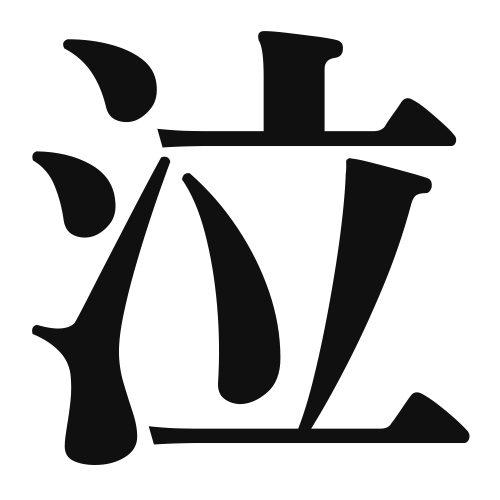1. Overview of Meaning
The kanji “泣” (naki) means “to cry” or “to weep.” It represents the act of shedding tears, often associated with emotions such as sadness, pain, or even joy.
2. Formation and Radical
Formation of the Kanji: The kanji “泣” is a phonetic-ideographic character (形声文字). It combines the water radical (氵) on the left, which relates to the act of crying, and the phonetic component “立” (tatsu) on the right, which contributes to its pronunciation.
Radical: The radical for “泣” is 氵, which is a variant of the water radical, indicating that the meaning is related to liquid, in this case, tears.
3. Examples of Usage
Common Words and Phrases:
- 泣く (naku) – to cry
- 泣き声 (nakigoe) – the sound of crying
- 泣き虫 (nakimushi) – a crybaby
Example Sentences in Daily Conversation:
- 彼女は映画を見て泣いてしまった。 (Kanojo wa eiga o mite naite shimatta.) – She ended up crying while watching the movie.
- 子供が泣いているので、何があったのか聞いてみてください。 (Kodomo ga naite iru node, nani ga atta no ka kiite mite kudasai.) – The child is crying, so please ask what happened.
4. Synonyms and Antonyms
Similar Kanji:
- 悲しい (kanashii) – sad; while “泣” refers specifically to the act of crying, “悲しい” describes the feeling that may lead to crying.
- 涙 (namida) – tears; this refers to the actual liquid that comes out when one cries.
Antonyms:
- 笑う (warau) – to laugh; this is the opposite of crying, representing joy and happiness.
5. Cultural and Historical Background
Connection to Japanese Culture: Crying is often seen as a natural expression of emotion in Japanese culture. It is not uncommon for people to express their feelings openly, especially in art and literature.
Proverbs and Idioms:
- 泣きっ面に蜂 (nakittsura ni hachi) – “A bee on a crying face”; this idiom means that when someone is already in a bad situation, things can get worse.
- 泣いて馬謖を斬る (naite bashoku o kiru) – “To cry while executing a traitor”; this phrase refers to making difficult decisions despite emotional pain.
